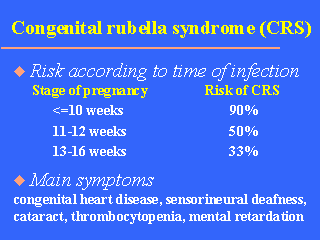 |
 |
front |1 |2 |3 |4 |5 |6 |7 |8 |9 |10 |11 |12 |13 |14 |15 |16 |17 |18 |19 |20 |21 |22 |23 |24 |25 |26 |27 |28 |29 | |
|
Search for most updated materials ↑
Rubella is usually a mild disease, but infection during the first 3-4
months of pregnancy can result in spontaneous abortion, stillbirth and congenital rubella
syndrome (CRS). The aim of every rubella immunisation programme is to prevent CRS. As the average age at infection prior to vaccination was about 8-10 years (in many
developed countries), immunising boys and girls in the second year of life is expected to
increase age at infection among the unimmunised. If vaccination coverage is low, there could (in theory) be an increase in the incidence
of rubella among older age groups and, therefore, an increase in the incidence of CRS. The
threshold of vaccination coverage below which there could be such an increase in the long
term has been estimated to 50-60%. By contrast, immunising adolescent girls does not interfere appreciably with age at
infection because immunisation is carried out after the pre-vaccination average age at
infection (therefore, by the time of vaccination most children will have already been
naturally infected). (Source of data: Miller E, Cradock-Watson JE, Pollock TM. Consequences of confirmed
maternal rubella at successive stages of pregnancy.
Lancet 1982; 2:781-4.)
|
